Danske Bank Bundle
Can Danske Bank Conquer the Future of Finance?
Danske Bank, a cornerstone of the Nordic financial services industry since 1871, faces a critical juncture. This analysis explores the Danske Bank SWOT Analysis, its growth strategy, and its future prospects within a rapidly evolving banking sector. We'll examine how this Danish banking giant plans to navigate technological advancements, changing customer demands, and rigorous regulatory landscapes.
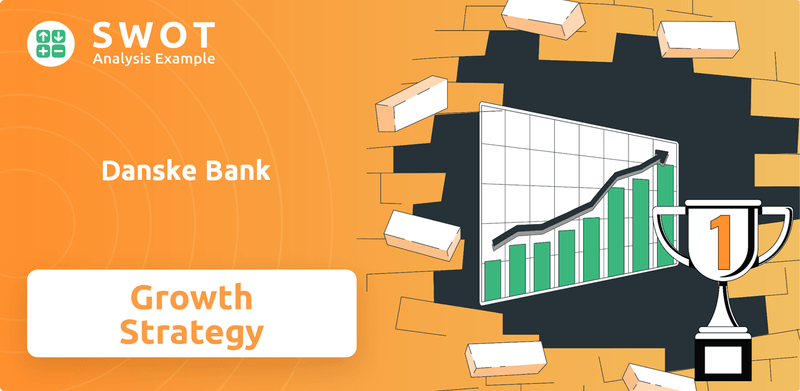
Understanding Danske Bank's strategic initiatives in 2024 is crucial for anyone seeking insights into the Danish banking market and the broader financial services industry. This exploration will uncover the bank's expansion plans and strategies, its digital transformation strategy, and its approach to sustainability goals. Furthermore, we'll assess the impact of economic conditions and the competitive landscape to evaluate Danske Bank's long-term growth potential and its ability to overcome challenges in the future of banking.
How Is Danske Bank Expanding Its Reach?
The expansion initiatives of Danske Bank are strategically focused on amplifying its presence within the Nordic region and enhancing its digital capabilities. This approach aims to attract new customers and solidify relationships with existing ones. While significant geographical expansion isn't the immediate priority, the bank is actively pursuing growth within its core markets, concentrating on attracting both personal and business clients, particularly in segments where there's potential for increased market penetration. This strategy is crucial for the Danske Bank Growth Strategy.
A key element of Danske Bank's growth strategy involves continuous development and launch of new products and services, with a digital-first approach. This includes upgrading mobile banking platforms, introducing innovative investment products, and streamlining lending processes to improve customer experience and accessibility. The bank is also investing in digital advisory capabilities to offer more personalized financial guidance to its customers, a critical component of their Danske Bank Future Prospects.
Furthermore, Danske Bank is exploring strategic partnerships, especially with fintech companies, to co-create solutions and integrate new technologies. These collaborations aim to extend service offerings and reach a wider audience. The bank consistently evaluates opportunities that align with its strategic objectives of strengthening its market position and diversifying revenue streams. This focus on organic growth, combined with strategic digital enhancements and collaborations, underscores the bank's commitment to long-term success in the Financial Services Industry.
Danske Bank is heavily investing in its digital infrastructure to enhance customer experience and operational efficiency. This includes upgrades to mobile banking apps, online platforms, and data analytics capabilities. The goal is to provide seamless and personalized services, which is a key aspect of their Danske Bank digital transformation strategy.
The bank is actively seeking partnerships with fintech companies to integrate new technologies and expand its service offerings. These collaborations help Danske Bank stay competitive and provide innovative solutions to its customers. This approach is crucial for navigating the Banking Sector Analysis.
Danske Bank is focused on developing and launching new products and services, particularly in investment and lending. This includes introducing new investment products and streamlining lending processes. This focus is essential for their Danske Bank expansion plans and strategies.
The primary focus remains on the Nordic markets, with targeted efforts to attract new personal and business customers. This includes expanding its presence in key segments where there is potential for growth. This is a core element of their Danske Bank Company strategy.
Danske Bank's expansion strategy includes a strong emphasis on digital transformation, strategic partnerships, and product innovation. These initiatives are designed to enhance customer experience and drive growth within the Nordic markets. The bank's commitment to sustainability also plays a significant role in its long-term strategy, as highlighted in Mission, Vision & Core Values of Danske Bank.
- Digital Banking Enhancements: Upgrading mobile and online platforms.
- Fintech Partnerships: Collaborating to integrate new technologies.
- New Product Launches: Introducing innovative investment and lending products.
- Market Penetration: Targeting key segments for customer acquisition.
Danske Bank SWOT Analysis
- Complete SWOT Breakdown
- Fully Customizable
- Editable in Excel & Word
- Professional Formatting
- Investor-Ready Format
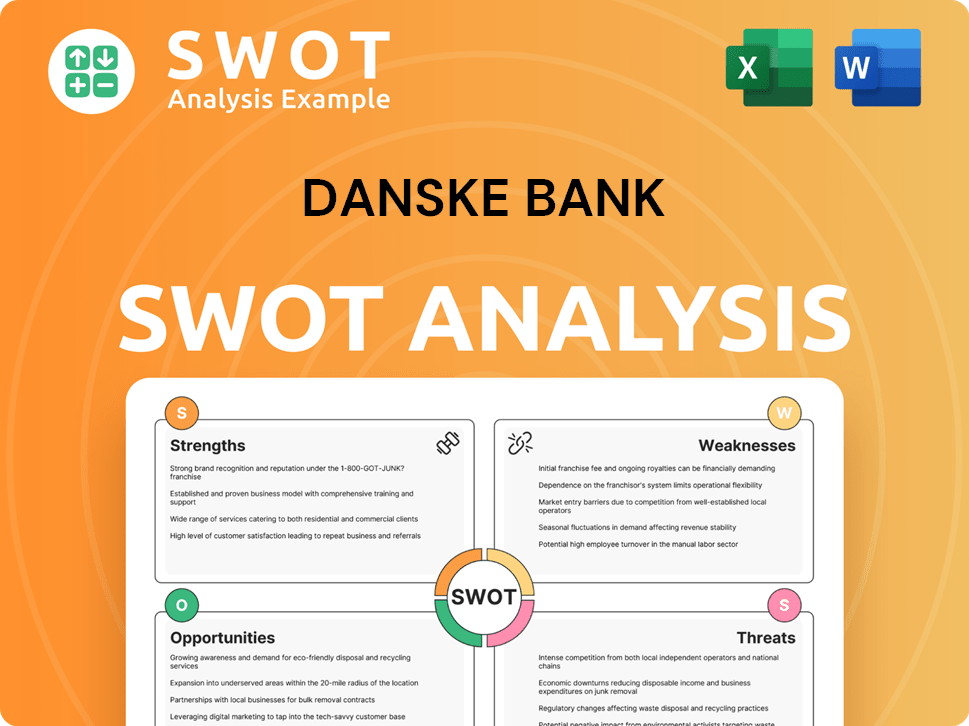
How Does Danske Bank Invest in Innovation?
Innovation and technology are pivotal to the Danske Bank Growth Strategy, driving its future prospects within the Financial Services Industry. The bank is strategically investing in digital transformation, automation, and advanced technologies to enhance customer experiences and streamline operations. This approach is crucial for maintaining a competitive edge in the Banking Sector Analysis and the Danish Banking Market.
Danske Bank's focus on technology includes the development of mobile banking applications and online platforms, aiming to provide seamless digital services. The bank is also actively exploring and implementing Artificial Intelligence (AI) and Machine Learning (ML) to personalize customer interactions, improve fraud detection, and automate routine tasks. These initiatives are designed to reduce operational costs, improve efficiency, and contribute to its growth objectives.
The bank's commitment to sustainability is evident through the use of digital tools that help customers manage their environmental footprint. While specific details on patents or industry awards are not always publicly highlighted, the bank's consistent investment in digital solutions and customer-centric platforms underscores its commitment to innovation. These efforts are part of Danske Bank's strategic initiatives 2024, designed to attract and retain a digitally-savvy customer base.
Danske Bank is undergoing a significant digital transformation to modernize its services and improve customer experience. This includes investments in cloud computing, data analytics, and cybersecurity. The bank aims to enhance its digital channels, making them more user-friendly and efficient.
The bank is leveraging AI and ML to automate tasks, personalize customer interactions, and improve fraud detection. AI-powered chatbots are used to handle customer inquiries, and data analytics are employed to offer tailored financial advice. This technology helps improve operational efficiency.
Danske Bank is continuously developing its mobile banking applications and online platforms to provide seamless and intuitive digital services. These platforms are designed to offer a wide range of banking services, making it easier for customers to manage their finances. The focus is on user experience and accessibility.
Danske Bank is committed to sustainability, offering digital tools that help customers understand and manage their environmental footprint. These tools are integrated into the bank's digital platforms, promoting eco-friendly financial choices. The bank aims to integrate sustainability into its core operations.
Danske Bank actively invests in fintech to stay competitive and enhance its service offerings. This includes collaborations with fintech companies and investments in innovative technologies. The bank's investment in fintech supports its digital transformation strategy.
The bank uses data analytics to gain insights into customer behavior, improve decision-making, and personalize services. Data analytics supports risk management and helps the bank offer tailored financial products. This improves customer satisfaction and operational efficiency.
Danske Bank's digital transformation efforts are designed to reduce operational costs, improve efficiency, and contribute to its growth objectives by attracting and retaining a digitally-savvy customer base. The bank's investments in technology align with its long-term growth potential and address the challenges and opportunities in the banking sector. For a deeper understanding of the bank's origins and evolution, consider reading a Brief History of Danske Bank.
Danske Bank's technology strategy focuses on enhancing customer experience, streamlining operations, and improving data analytics. Key areas of investment include:
- Cloud Computing: Migrating to cloud-based services for scalability and efficiency.
- Cybersecurity: Strengthening cybersecurity measures to protect customer data and prevent fraud. In 2024, cybersecurity spending in the financial sector is projected to reach record levels, reflecting the increasing threats.
- AI-Powered Chatbots: Utilizing AI chatbots for customer service and support.
- Data Analytics Platforms: Implementing advanced data analytics tools for informed decision-making and personalized customer services. The global data analytics market in banking is expected to reach $7.5 billion by 2025.
Danske Bank PESTLE Analysis
- Covers All 6 PESTLE Categories
- No Research Needed – Save Hours of Work
- Built by Experts, Trusted by Consultants
- Instant Download, Ready to Use
- 100% Editable, Fully Customizable
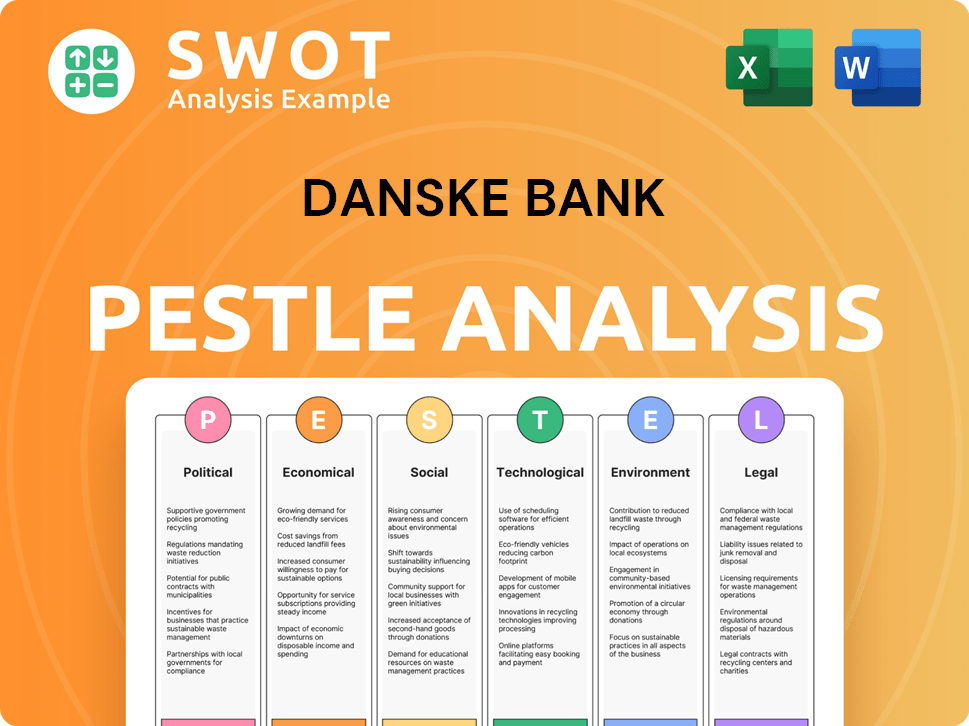
What Is Danske Bank’s Growth Forecast?
The financial outlook for Danske Bank reflects a strong commitment to sustainable growth, supported by its strategic initiatives and a focus on operational efficiency. For the full year 2024, the bank anticipates a net profit within the range of DKK 20-22 billion. This projection indicates a positive trajectory, building on the bank's recent performance and strategic direction in the Marketing Strategy of Danske Bank.
Danske Bank's financial performance in 2023 demonstrated significant improvement. The bank reported a net profit of DKK 21.3 billion, a substantial increase from DKK 4.8 billion in 2022. This rise was primarily driven by higher income and lower impairments, showcasing the effectiveness of its risk management and revenue generation strategies. This financial performance underscores the bank's resilience and its ability to navigate the complexities of the Financial Services Industry.
Looking forward, Danske Bank aims to achieve a return on tangible equity (ROTE) of above 13% by 2026. This ambitious target highlights the bank's focus on profitability and efficient capital utilization. The bank's strategic initiatives are designed to enhance customer experience, streamline operations, and drive revenue growth, all contributing to its long-term financial goals. The bank's strong capital position, with a Common Equity Tier 1 (CET1) capital ratio of 17.6% at the end of 2023, provides a solid foundation for future growth and allows for potential investments.
Danske Bank projects a net profit between DKK 20-22 billion for 2024. This forecast reflects the bank's confidence in its strategic initiatives and its ability to maintain strong financial performance. The Banking Sector Analysis of Danske Bank shows a consistent focus on profitability and sustainable growth.
The bank aims for a ROTE above 13% by 2026. This target underscores Danske Bank's commitment to enhancing shareholder value and optimizing capital allocation. This goal is supported by the bank's ongoing efforts to improve operational efficiency and increase revenue streams.
Danske Bank maintains a robust capital position, with a CET1 capital ratio of 17.6% at the end of 2023. This strong capital base provides a buffer against economic uncertainties and supports the bank's strategic investments. The Danish Banking Market benefits from the bank's financial stability.
In 2023, Danske Bank achieved a net profit of DKK 21.3 billion, a significant increase from DKK 4.8 billion in 2022. This improvement was driven by higher income and lower impairments. This positive trend indicates the effectiveness of the bank's strategies and its ability to adapt to market conditions.
Danske Bank's strategic focus includes enhancing customer experience, streamlining operations, and driving revenue growth. These initiatives are designed to support the bank's long-term financial goals and create value for shareholders. The bank is also investing in digital transformation to improve efficiency and customer service.
The bank's strong capital position allows for potential investments in technology and expansion initiatives. These investments are crucial for Danske Bank's long-term growth potential and its ability to adapt to the evolving financial landscape. The bank is also exploring mergers and acquisitions outlook to strengthen its market position.
Danske Bank Business Model Canvas
- Complete 9-Block Business Model Canvas
- Effortlessly Communicate Your Business Strategy
- Investor-Ready BMC Format
- 100% Editable and Customizable
- Clear and Structured Layout
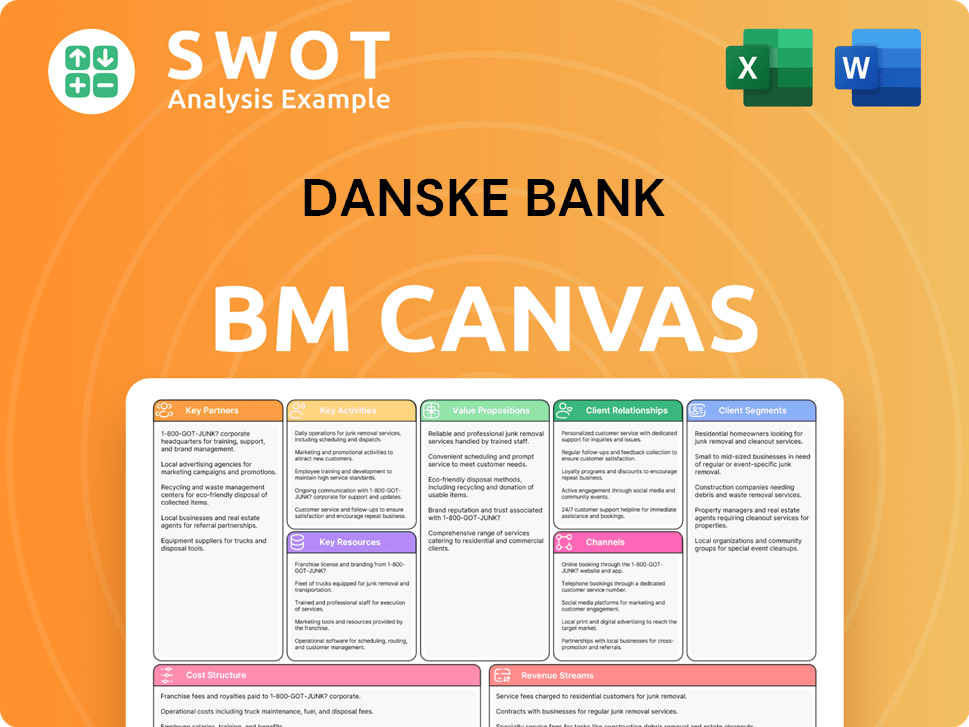
What Risks Could Slow Danske Bank’s Growth?
The Danske Bank Company, like any major financial institution, navigates several risks and obstacles that could affect its growth. These challenges span competitive pressures, regulatory changes, technological disruptions, and macroeconomic factors. Understanding these potential hurdles is crucial for assessing the bank's long-term growth prospects and strategic initiatives.
One of the primary challenges for Danske Bank is the competitive landscape within the financial services industry, especially in the Danish Banking Market and other Nordic countries. The rise of fintech companies and established players intensifies competition, potentially squeezing profit margins. Furthermore, the banking sector faces constant regulatory scrutiny, including stringent requirements for anti-money laundering (AML), data privacy (GDPR), and capital adequacy, which demand significant investment in compliance and risk management.
Technological advancements and macroeconomic conditions also present significant risks. The need to adapt to rapid technological changes and cybersecurity threats necessitates continuous investment and innovation. Fluctuations in interest rates, inflation, and economic downturns in key markets could impact lending volumes, asset quality, and overall profitability, requiring robust risk management strategies and diversification.
The Nordic banking market is highly competitive, with both established banks and emerging fintechs vying for market share. This necessitates continuous innovation and customer acquisition strategies to maintain a competitive edge. The bank's market share analysis is a key factor.
The financial services industry is subject to stringent and evolving regulations, particularly concerning AML, data privacy, and capital requirements. Non-compliance can lead to substantial fines and reputational damage, as seen in past challenges. Risk management and compliance are crucial.
Rapid technological advancements require constant adaptation and integration of new solutions to remain competitive. Cybersecurity threats also pose a significant risk, necessitating robust security measures to protect customer data. Danske Bank's digital transformation strategy is key.
Interest rate fluctuations, inflation, and economic downturns in core markets can affect lending volumes, asset quality, and overall profitability. Diversification of business activities and comprehensive risk management frameworks are essential. The impact of economic conditions is significant.
Cybersecurity threats are a major concern, requiring continuous investment in robust security measures to protect customer data and maintain trust. These threats can undermine customer confidence and lead to financial losses. Danske Bank's investment in fintech is crucial.
Economic downturns and fluctuations in key markets can significantly affect lending volumes and asset quality. Danske Bank must navigate these challenges through strategic planning and robust financial performance review processes. Long-term growth potential depends on it.
Danske Bank employs comprehensive risk management frameworks to address various challenges, including those related to credit, market, and operational risks. These frameworks include detailed policies, procedures, and monitoring systems. The bank's risk management and compliance efforts are crucial.
The bank is investing heavily in digital resilience to mitigate technological disruptions and cybersecurity threats. This includes strengthening its IT infrastructure, enhancing data protection measures, and improving its ability to respond to cyberattacks. Danske Bank's digital transformation strategy is a priority.
Danske Bank focuses on operational efficiency to streamline processes and reduce costs. This involves automation, process optimization, and the use of advanced analytics. This focus helps improve profitability and competitiveness. Danske Bank's expansion plans and strategies are influenced by this.
The bank utilizes scenario planning to assess its resilience to various economic conditions and market changes. This includes stress testing and modeling to prepare for potential downturns. The impact of economic conditions is a key consideration.
Danske Bank Porter's Five Forces Analysis
- Covers All 5 Competitive Forces in Detail
- Structured for Consultants, Students, and Founders
- 100% Editable in Microsoft Word & Excel
- Instant Digital Download – Use Immediately
- Compatible with Mac & PC – Fully Unlocked
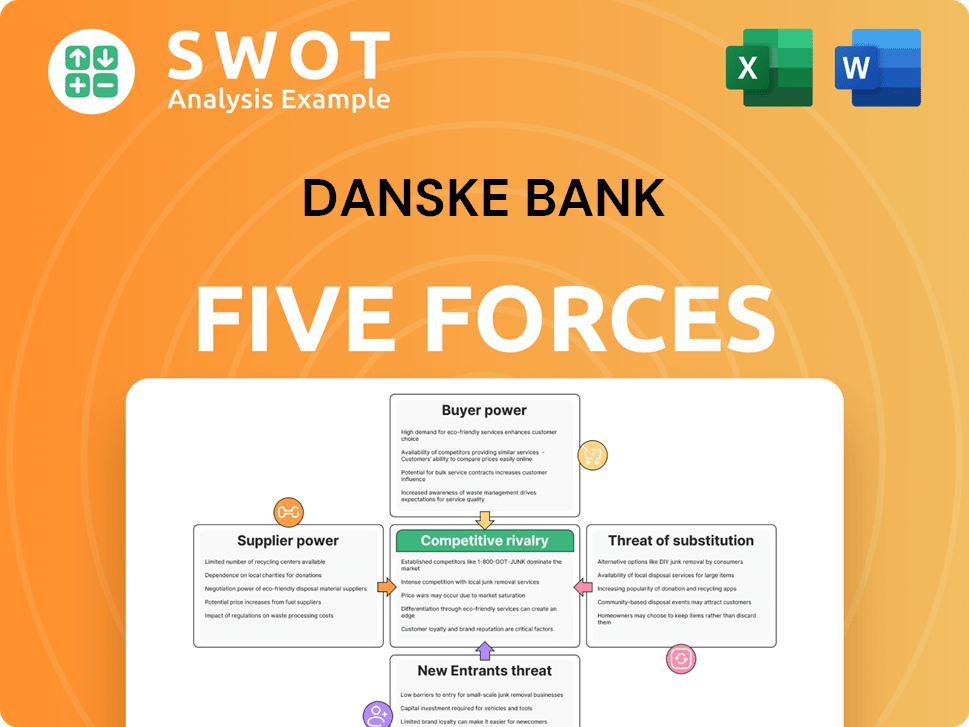
Related Blogs
- What are Mission Vision & Core Values of Danske Bank Company?
- What is Competitive Landscape of Danske Bank Company?
- How Does Danske Bank Company Work?
- What is Sales and Marketing Strategy of Danske Bank Company?
- What is Brief History of Danske Bank Company?
- Who Owns Danske Bank Company?
- What is Customer Demographics and Target Market of Danske Bank Company?
Disclaimer
All information, articles, and product details provided on this website are for general informational and educational purposes only. We do not claim any ownership over, nor do we intend to infringe upon, any trademarks, copyrights, logos, brand names, or other intellectual property mentioned or depicted on this site. Such intellectual property remains the property of its respective owners, and any references here are made solely for identification or informational purposes, without implying any affiliation, endorsement, or partnership.
We make no representations or warranties, express or implied, regarding the accuracy, completeness, or suitability of any content or products presented. Nothing on this website should be construed as legal, tax, investment, financial, medical, or other professional advice. In addition, no part of this site—including articles or product references—constitutes a solicitation, recommendation, endorsement, advertisement, or offer to buy or sell any securities, franchises, or other financial instruments, particularly in jurisdictions where such activity would be unlawful.
All content is of a general nature and may not address the specific circumstances of any individual or entity. It is not a substitute for professional advice or services. Any actions you take based on the information provided here are strictly at your own risk. You accept full responsibility for any decisions or outcomes arising from your use of this website and agree to release us from any liability in connection with your use of, or reliance upon, the content or products found herein.